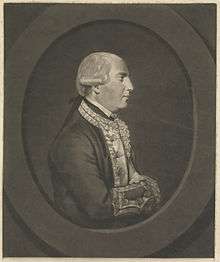John Elphinstone
John Elphinstone, also known as John Elphinston (1722 – 28 February 1785), was a senior British naval officer who worked closely with the Russian Navy after 1770, with approval from the Admiralty, during the period of naval reform under Russian Empress Catherine II. Together with the Scottish-born Samuel Greig, or Samuil Karlovich Greig (Самуил Карлович Грейг), as he was known in Russia, and Admiral Sir Charles Knowles, Elphinstone was a member of the naval staff, headed by Count Alexei Grigoryevich Orlov, which, though it lacked naval experience, was able to defeat the Turkish fleet at the Battle of Chesma Bay, near Chios Island, off the far western coast of Turkey. [1]

Early life
He was born at Lopness, near Sanday in the Orkney Islands, the son of John Elphinstone and his wife Anne Williams and joined the Royal Navy.
He was promoted commander of the fireship HMS Salamander in 1757, serving under Commodore Hon. Richard Howe in his 1758 campaign against the French Channel ports. During one attack he was captured by the French.
After his release in 1759 he was made captain of the 20-gun HMS Eurus and took part in the capture of Quebec. In 1761 he was in command of HMS Richmond when she captured and destroyed the 32-gun French ship Félicité at Scheveningen. Later that year Elphinstone captured two other French privateers. In 1762 Richmond sailed out to the West Indies and Elphinstone was put in charge of transport services during the siege of Havana. He afterwards brought back the 70-gun prize ship Infanta.
At the end of 1763 he commissioned the guard ship HMS Firm at Plymouth, commanding her for three years.
Russian Service
Catherine II of Russia drew on the experience of British naval personnel through the networking in London of the British Ambassador in St. Petersburg from 1769 to 1771, Lieutenant-General Charles Cathcart, 9th Lord Cathcart. He was married to Jane Hamilton, but Jane's death in Saint Petersburg during an outbreak of the plague, prompted his return to Britain.
Elphinstone was one of a small number of British officers who joined the Catherine's Russian service in the summer of 1769, and was given the rank of rear-admiral. In 1770 he led a squadron from the Baltic to the Mediterranean to take part in the war against the Turks and participated in the defeat of a Turkish fleet in Battle of Chesma Bay. He, however, was on such bad terms with his Russian superiors, particularly Count Aleksei Orlov, that he left the Russian service in July 1771.
Russian naval history relates that he did not resign by his own choice, but was rather relieved of command after his ship-of-the-line, the 80-gun Svyatoslav, ran onto a reef and was subsequently burned after an unsuccessful effort to move her lasting six days. The pilot for this disastrous raid (which was not approved by Orlov) was British and the protege of Elphinstone. The pilot was subsequently court-martialled and sentenced to death, but somehow managed to escape and flee. Elphinstone himself was never sentenced, but was dismissed from the service and had to return home. His memoirs were understandably biased after that and met with harsh reprimand from Catherine the Great, who went so far as to call him a madman.
Later life
John Elphinstone later held several further commands in the British Royal Navy, including that of the 74-gun HMS Magnificent during Admiral Sir George Rodney's West Indian Campaign of 1779-80.
He died in 1785 in Broad Street, Carnaby Market, London. He had married Amelia Warburton in 1750 and had six sons and four daughters. They included:
- John, a post captain, who died in 1801
- Samuel William, who died as a captain in the Russian service in 1788
- Thomas, who reached the same rank in the navy before his death in 1821
- Robert Phillip, who died as a post captain in 1822
- Major-General Sir Howard Elphinstone
- Anna-Charlotta-Maria, who married Captain Sir Francis John Hartwell
References
- ((url=https://morethannelson.com/officer/john-elphinstone-1/%7Ctitle=John Elphinstone|accessdate=6 January 2018))
- John Elphinston Papers Relating to the Russo-Turkish War, 1769-1850 (bulk 1769-1771): Finding Aid at Princeton University
- "Scottish Influences in Russian History"
- Bartlett, Roger and Hughes, Lindsey, Dr. (eds.). Russian Society and Culture and the Long Eighteenth Century: Esays in Honour of Anthony G. Cross. Paperback, Lit Verlag, 2005. ISBN 978-3-8258-7771-2; ISBN 3-8258-7771-X.
- Anthony G. Cross. By the Banks of the Neva: Chapters from the Lives and Careers of the British in Eighteenth-Century Russia. Cambridge: Cambridge University Press, 1997. (Anthony Cross was Professor of Slavonic Studies at the University of Cambridge from 1985 to 2004. Previously, he was Reader in Russian at the University of East Anglia and Roberts Professor of Russian at the University of Leeds. He was elected to the British Academy in 1989 and to the Russian Academy of the Humanities in 1996.)
- Schop Soler, Ana María. Un siglo de relaciones diplomáticas y comerciales entre España y Rusia : 1733-1833 Madrid: Ministerio de Asuntos Exteriores, Dirección General de Relaciones Culturales, D.L. (1984), 520 pages; 24 cm. In Spanish.
- Schop Soler, Ana María. Las relaciones entre España y Rusia en la época de Fernando VII (1808-1833), Barcelona, Universidad de Barcelona, (1975). In Spanish.
- Schop Soler, Ana María. Las relaciones entre España y Rusia en la época de Carlos IV Ana María, Schop Soler; prólogo de Carlos Seco Serrano. Editor: Barcelona: Cátedra de Historia General de España, 1971. xvii +196 pages; 21 cm. In Spanish. German Edition: Die Spanische-Russischen Beziehungen im 18. Jahrhundert. Wiesbaden: Otto Harrassowitz, (1970).